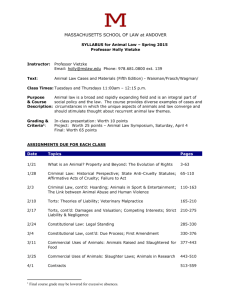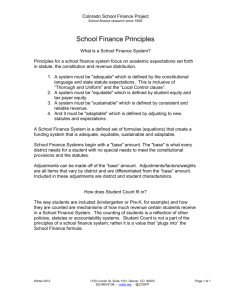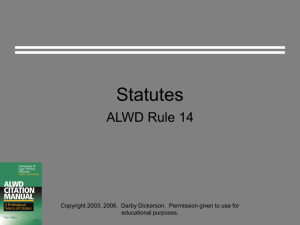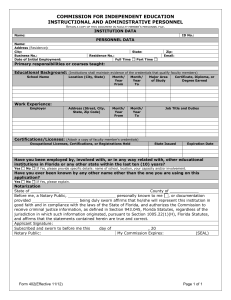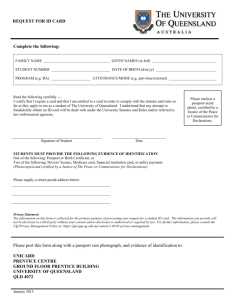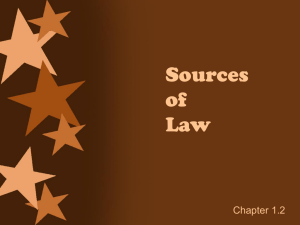Statutory Research
advertisement
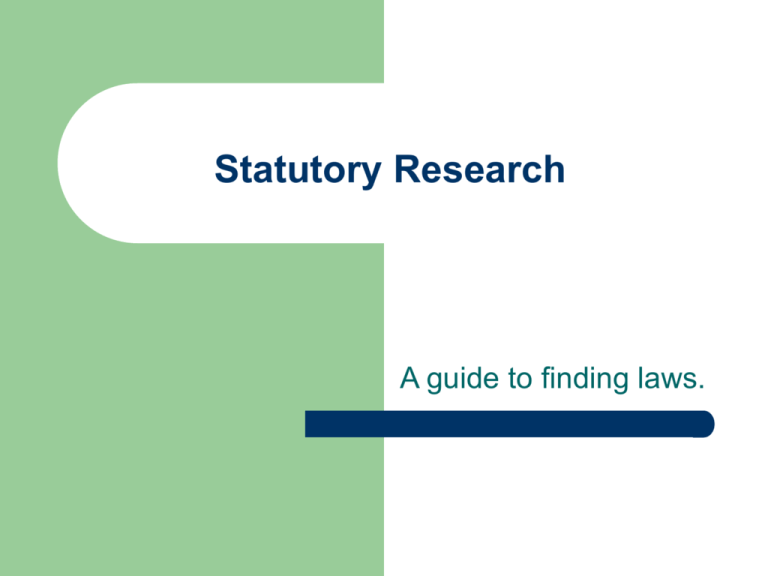
Statutory Research A guide to finding laws. What are Statutes? Statutes, also known as laws, are passed by either: 1) The U.S. Congress [federal statutes]; or 2) State legislatures [state statutes] Rules & Regulations Rules and regulations are NOT the same as statutes Rules and regulations are promulgated by administrative agencies, which are part of the executive branch of government—either federal or state government Agencies (e.g. IRS, EPA, & FAA) establish rules and regulations after being given mandates by the U.S. Congress (federal agencies) or state legislatures (state agencies). These rules and regulations are meant to aid the agencies in their efforts to meet those legislative mandates Finding Statutes To find federal laws: Use annotated federal statutes, i.e., United States Code Annotated (USCA) or United States Code Service (USCS) Note that the United States Code (USC) is the official reporter of federal statutes and we always cite to the USC and NOT the unofficial statutes. To find state laws: Use annotated state statutes, e.g., Florida Statutes Annotated or the Official Code of Georgia Annotated What is an Annotation? An annotation is a comment or explanation Annotations are explanations of statutes, which take the form of “headnotes,” “historical and statutory notes,” “library references,” and “notes to decisions.” These are all written by editors. Thus, they are NOT a part of the official document created by the legislature. Annotations point us to case law that has been rendered with respect to a particular statute, to scholarly works that discuss that point of law, and--in the case of West—to “key numbers.” Every different key number corresponds to a different narrow topic of law—these are uniform across all West case reporters and annotated statutes reporters; thus, giving us an easy tool to find additional statutes and cases on point. Never Cite to an Annotation Remember: Annotations are NOT a part of the actual statutory language passed by the legislative body and, thus, should never be cited to. Using Annotated Statutes Before starting your research, determine the terms which you feel most closely identify the topic for which you are trying to locate a statute(s). Ex: Our client is accused of putting a poisonous substance into the river. We would look up “Poisons” and then look for the subtopic “Waters and Waterways.” Always work from general to narrow. The index contains multiple subheadings to help lead you to the narrow issue at hand. Here, the main issue is the alleged poisoning. Using Annotated Statutes Once you have identified the main topic, go to the index of the annotated statute set and look for each term. Often the index will direct you to other terms better-suited for your search. Ex: Florida’s statutes relating to family law are found in Title XLIII entitled “Domestic Relations.” However, if you were to look in the General Index of the Florida Annotated Statutes under “family law,” the index would ask you to look under “Domestic Relations.” The index will lead you to the proper section of the law within the annotated statute set in which to find the statute(s). You will notice the section numbers on the spines of the volumes. Analyzing Results Ensure that you have the most current version of the statute Check all supplemental volumes. That is, pocket parts (located in the back-binding of the book) and paper supplements (sometimes called pamphlets). When using the Florida Annotated Statutes, be sure to check the Interim Annotation Service (paper supplement located on the shelves prior to the General Index), which updates the pocket parts. Read the “Historical and Statutory Notes” (legislative history) Found immediately following the text of the statute These tell us when the statute was initially enacted and whether it has been modified or repealed and, if so, when Finding Associated Case Law Read the case digests that follow the text of the statute. These follow the Historical and Statutory Notes Contain brief descriptions of cases that have involved the narrow point of law covered by that particular statute. Once you have case citations, you can easily find the cases in the appropriate case reporter. Citing to Federal Statutes Always cite to the United States Code (USC), which is the official reporter of statutes passed by the U.S. Congress. Cite as follows: 17 U.S.C. § 1201 (2000 & Supp. ? 2001) Remember: Use the unofficial or annotated statutes (USCA or USCS) for researching and finding laws on a topic, but always cite to the official version of the code. Refer to Rule 12 in the Bluebook, if you have any questions. Citing to Florida Statutes The official reporter of FL laws are the “Florida Statutes.” Cite as follows: § 859.01, Fla. Stat. (2003). Florida Statutes are codified and printed every year. In citing to statutory materials which do NOT appear in the official reporter, one may cite to the annotated versions of the statutes in the following manner: § 857.102, Fla. Stat. Ann. (2000 & Supp. 2004). Note the way in which the supplement is cited to. Citing to Other States’ Statutes Refer to the Bluebook for the citation formats of other jurisdictions Table T.1 contains each U.S. jurisdiction and its associated citation rules Rule 12 contains a more detailed description of the proper citation methods used for statutes The Florida Constitution The Florida Constitution is NOT a compilation of statutes, although it can be found in the Florida Statutes Annotated. The [U.S.] Constitution states that any powers not specifically given to the federal government are the responsibility of the state. The details of a state government's structure and responsibilities are defined by each state’s constitution. Look under “Constitution” in the index of the Florida Statutes Annotated (and its subtopics) to find the parts of the document that relate to the topic you are researching. Citing to the Florida Constitution The Florida Constitution is cited as follows: Art V, § 3(b)(3), Fla. Const. The first portion before the comma represents the article of the constitution which one is citing. The second portion represents the section within the Article. Finally, the last portion stands for the state constitution which is being cited, here, the Florida Constitution. Citing to Other State Constitutions Since the Florida appellate rules do not set forth model citations for the constitutions of other states or for the Federal Constitution. Accordingly, the Bluebook provides the proper citation methods. The constitutions from other states are cited as follows, using New York and Texas as examples: N.Y. Const. art. IV, § 7. Tex. Const. art. II, § 1. United States Constitution The text of the United States Constitution is contained within the United States Code (USC). However, for research purposes, you may want to use the USCA or USCS, which also contain the text of the Constitution, as amended, with helpful annotations. As discussed previously, use the index to these annotated statutes (USCA or USCS). Look under “Constitution” and find the appropriate subtopic. Citing to the U.S. Constitution Provisions of the Constitution of the United States should be cited as follows: U.S. Const. preamble. U.S. Const. art. I, § 9, cl. 3. U.S. Const. amend. XIV, § 1. Summary: Finding Laws Use the index of an annotated statutes reporter. Find related statutes. Make sure you are looking at the most recent version of each statute by checking all of the supplements. Read the annotations to obtain the history of the legislation, citations to scholarly writings on the subject, and related case law. If you need further assistance, please feel free to contact the Reference Desk either in person, via phone 680-7612, or via email: refdesk@fcsl.edu
